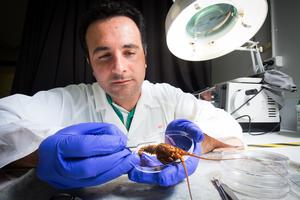Dr Tomer Ventura, a USC-based Israeli researcher, is undertaking research to manipulate the sex of rock lobster species, working with Associate Professor Stephen Battaglene and Dr Quinn Fitzgibbon from IMAS through the Collaborative Research Network Aquaculture Program.
While sex change is a well-known natural phenomenon in the in the marine world, in most reproductive species this does not occur naturally. Nevertheless, according to Dr Ventura, certain crustacean species alter sex naturally to extend their mating season.
One such species is the colourful reef-inhabiting cleaner shrimp which pairs up and then switch roles: first one acts as the male and mates with the female which then carries the eggs, during which period the male switches to female while the female switches to male.
Unique gland

A bit confusing, yet generally speaking a unique gland determines masculinity in crustaceans, at least in those species such as lobsters, prawns, crabs and crayfish where sex does not change naturally. Without this gland an individual animal is heading towards a female future.
The project has special significance for Associate Professor Battaglene, who also leads the Australian Research Council (ARC) Research Hub for Commercial Development of Rock Lobster Culture Systems, an international initiative headquartered at the IMAS Taroona campus.
The world-leading tropical and temperate rock lobster research puts Australia at the cutting edge of aquaculture, with the Taroona facility the home of a globally-recognised and funded study to mass produce lobster seed stock.
“Research in the hub focuses on broodstock management, larval-rearing systems, metamorphosis systems and health. This research, along with gender manipulation technologies, has the potential to significantly improve the commercial viability of rock lobster aquaculture,” Associate Professor Battaglene explains.
Value-adding
For Dr Ventura, the artificially-manipulated process is one with value-added application in prawns, shrimps, lobsters, crabs and crayfish.
Several decades ago a gland was discovered which determines whether a crustacean becomes a male or a female. The gland is separate from the gonads (testis or ovary), so that we can manipulate it without tempering the gonad.
“In early development the young lobsters still have an undifferentiated gonad so that development can be directed towards them becoming male or female, thanks to this gland.
Gene silencing
“We can either remove or graft this gland, or nowadays use what we call gene silencing – which is using a natural, biodegradable compound to knock down the key gene produced by this gland,” Dr Ventura said.
The silencing has been done with the giant river prawns and is now commercially available. In this species males grow faster and reach higher weights, benefiting farmers with up to doubled income.
“Here we are targeting rock lobster and red claw crayfish and hope to achieve 100 per cent male or female stocks."
Research in the ARC Research Hub for Commercial Development of Rock Lobster Culture Systems is undertaken in partnership with USC and University of Auckland, Australian industry partners JSA Engineers and Plastic Fabrications Group, and international partner Nexus Aquasciences Sdn Bhd, a subsidiary of Darden Restaurants Inc.
Interested in conducting your own research? Apply now to become a research student.